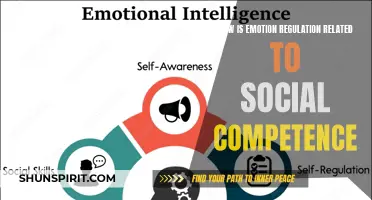
Foxes are cunning creatures known for their expressive faces and bushy tails, but did you know that these sensational tails are more than just a fashion statement? Yes, they are the ultimate emoticons of the animal kingdom! Just like humans use facial expressions to convey their emotions, foxes showcase their feelings through the mesmerizing movements of their fluffy tails. So, get ready to delve into the fascinating world of foxy emotions and learn how their tails can speak volumes without uttering a single word!
What You'll Learn

How do foxes use their tails to communicate?
Foxes are intelligent and highly adaptable creatures, known for their impressive communication skills. Their tails play a crucial role in conveying various messages to other foxes and even to humans. Understanding the different tail movements and positions can help us decode their emotions and intentions.
Wagging: A sign of happiness or excitement
When a fox wags its tail, it is usually a sign of happiness or excitement. You might notice the tail wagging vigorously from side to side in a relaxed manner. This movement indicates that the fox is content and feeling playful. It's a friendly gesture often seen when foxes are interacting with their siblings or mates. When encountering humans or other animals they trust, they may wag their tails to show their friendly intentions. It's important to note that not all foxes wag their tails in the same way, so it's essential to consider other body language cues to understand the full context.
Tucking: Indicates fear or submission
On the other side of the spectrum, when a fox tucks its tail tightly between its hind legs, it is a clear indication of fear or submission. In this posture, the fox tries to make itself appear smaller and less threatening. It may also lower its body or crouch to the ground, signaling its submissive nature. This behavior is often seen when a fox encounters a dominant individual or feels threatened by a potential predator. It's crucial to give the fox space and avoid any actions that may escalate its fear or stress levels.
Stiff and straight: Sign of aggression or alertness
When a fox positions its tail stiff and straight, pointing upwards or slightly curved, it is a sign of aggression or high alertness. This posture is meant to make the fox appear larger and more intimidating. It is frequently accompanied by other aggressive behaviors, such as baring teeth, growling, or raising the hackles on its back. This tail position is a clear warning sign that the fox is feeling threatened or ready to defend itself. It's essential to give the fox plenty of space and avoid any actions that may provoke it further.
When observing foxes, it's essential to consider their entire body language, including facial expressions, ear positions, and overall posture. The tail is just one piece of the puzzle, and interpreting it correctly requires taking into account the entire context of the situation. If you encounter a fox, remember to appreciate them from a safe distance and avoid actions that may cause them stress or harm. By understanding their communication methods, we can coexist peacefully with these magnificent creatures.
Using CBT Techniques to Overcome Emotional Abuse
You may want to see also

Can foxes express emotions through different tail positions?
The tail is an essential part of a fox's body language, and they can use it to communicate various emotions and intentions. By understanding the different tail positions and their meanings, you can gain insight into a fox's emotional state. Let's explore some common tail positions and what they indicate.
Curved or relaxed: Indication of contentment or relaxation
When a fox's tail is curved or relaxed, it usually means that the fox is content and at ease. A gently curved tail is a sign of relaxation and shows that the fox is in a comfortable state. You might observe this tail position when a fox is resting or grooming itself. It's a positive sign that the fox feels safe and secure in its environment.
Fluffed and raised: Sign of agitation or fear
If you come across a fox with a fluffed and raised tail, it's a clear indication that the fox is feeling agitated or fearful. When a fox feels threatened or scared, it instinctively fluffs up its tail to appear larger and more intimidating. This tail position is often accompanied by other defensive behaviors, such as baring their teeth or growling. If you notice a fox with a fluffed and raised tail, it's best to give it space and avoid any sudden movements that may further agitate it.
Slowly swaying: A way to show curiosity or uncertainty
When a fox's tail is slowly swaying from side to side, it typically means that the fox is curious or uncertain about something in its surroundings. This tail position is often observed when a fox encounters a new object or an unfamiliar smell. By swaying its tail, the fox is trying to gather more information and assess the situation. If you encounter a fox with a slowly swaying tail, it's best to observe from a distance and avoid approaching too closely.
It's important to note that tail positions should be considered in conjunction with other body language cues to get a complete understanding of a fox's emotional state. Observing their overall behavior, facial expressions, and vocalizations can provide additional insights into how they are feeling. Remember to always respect a fox's space and observe from a safe distance, as they are wild animals and may react unpredictably.
Understanding the different tail positions that foxes use to express their emotions can help us coexist with these beautiful creatures and appreciate their natural behaviors. Take the time to observe and learn from them, but always prioritize their well-being and safety.
Discovering Hope and Healing after an Emotional Affair
You may want to see also

Do foxes use their tails to interact with other foxes?
When it comes to fox behavior, their tails play a significant role in communication and social interactions. Foxes use their tails in various ways to interact with other foxes, depending on the situation and the message they want to convey. In this article, we will explore three common tail interactions among foxes: tail flicking, tail touching or intertwining, and tail motion in hunting.
Tail flicking is a behavior often seen when foxes are playing or engaging in social interactions. It is a quick and deliberate movement of the tail that serves as a signal. When a fox flicks its tail, it is usually indicating to other foxes that it is in a playful mood and inviting them to join in the fun. This behavior is particularly common among young foxes, but adults also engage in tail flicking to initiate play or show their friendly intentions.
Another tail interaction seen in foxes is tail touching or intertwining. This behavior is more specific to the mating season or close social bonding. When two foxes engage in tail touching or intertwining, it is a sign of affection and a way to reinforce their bond. This behavior is usually seen between a male and female fox during courtship or after mating. It is also seen among members of a fox family, particularly between parents and their offspring.
In hunting situations, foxes use their tails to coordinate movements with other foxes. Tail motion in hunting plays a crucial role in directing and signaling their hunting strategies. When foxes hunt in a pack, they often use their tails to communicate with each other silently. A flick of the tail can signal to other foxes to flank their prey or change their direction. By coordinating their movements using their tails, foxes increase their chances of success in catching prey.
To summarize, foxes use their tails in a variety of ways to interact with other foxes. Tail flicking is common when playing or engaging in social interactions, and it serves as an invitation for others to join in the fun. Tail touching or intertwining is seen during mating season or close social bonding, indicating affection and reinforcing bonds. Tail motion in hunting helps foxes coordinate their movements during a hunt, increasing their chances of catching prey. Understanding these tail interactions provides valuable insights into the complex social lives of foxes.
Navigating Emotional Abuse: Healing and Growth for Couples
You may want to see also

How do other animals perceive fox tail movements?
When it comes to communication, animals have their own unique ways of conveying messages to each other. This is certainly true for foxes, whose tail movements play an important role in their communication system. Understanding how other animals perceive fox tail movements can give us valuable insights into their behavior and interactions with other species.
For predators, certain tail movements may be interpreted as a defense mechanism or warning by foxes. When a fox feels threatened or senses danger, it may raise its tail in an upright position and puff it out, making itself appear larger and more imposing. Predators, such as wolves or coyotes, may interpret this tail gesture as a sign that the fox is ready to defend itself. This display of confidence can deter potential attackers, as they may view the fox as a formidable opponent.
On the other hand, prey animals are more likely to perceive fox tail movements as a sign of danger or potential threat. When a fox is on the hunt, it may keep its tail low to the ground and move it back and forth in a swaying motion. This tail behavior is often accompanied by a stalking posture, which helps foxes blend into their surroundings. Prey animals, such as rabbits or squirrels, may recognize these tail gestures as a warning of an approaching predator. They may then take evasive action, such as hiding or fleeing, to avoid becoming a fox's next meal.
Within their own species, foxes understand and respond to various tail movements as a means of communication. They rely on their tails to convey social hierarchy, show aggression, or express submission. For example, during aggressive encounters, a dominant fox may hold its tail high and stiff, while a submissive fox may tuck its tail between its legs. This helps establish and maintain a clear social structure within the fox community.
Furthermore, foxes also use their tails to communicate intentions during mating and courtship rituals. A female fox may signal her readiness to mate by lifting and twitching her tail, while a male fox may wag his tail in an excited manner. These tail movements allow foxes to communicate their reproductive status and facilitate successful mate selection.
In conclusion, the tail movements of foxes can convey a wealth of information to other animals. Predators may interpret certain tail movements as a defense mechanism or warning, while prey animals may respond to tail gestures as a sign of danger or potential threat. Within their own species, foxes use various tail movements to communicate social hierarchy, aggression, submission, and reproductive intentions. Understanding these communication signals can provide valuable insights into the fascinating world of fox behavior and interactions with other animals.
Finding Love After Emotional Abuse: Would You Date Someone Who Overcame Past Trauma?
You may want to see also
Frequently asked questions
Yes, just like dogs, foxes will wag their tails when they are happy or excited. A wagging tail is a clear indication that a fox is feeling positive emotions and is content in its environment.
Yes, a fox's tail can communicate a range of emotions, including fear and aggression. When a fox is scared or feels threatened, it will often tuck its tail under its body as a defensive mechanism. On the other hand, if a fox is feeling aggressive or is preparing to attack, it may hold its tail high and stiff, demonstrating its readiness to defend itself.
Absolutely! Foxes use their tails as a form of communication with other members of their species. They can use different tail movements and positions to signal information such as dominance, submission, or territorial boundaries to other foxes. A fox may also use its tail to signal playfulness or interest in another fox.
While it is possible to interpret some of a fox's emotions through its tail movements, it is important to note that humans may not always accurately understand the full range of emotions a fox is experiencing. The tail is just one aspect of a fox's overall body language, and it should be considered alongside other behaviors and cues to gain a better understanding of a fox's emotional state.







